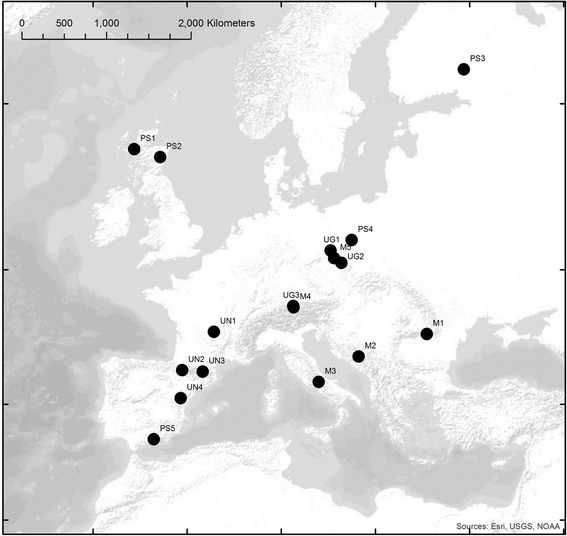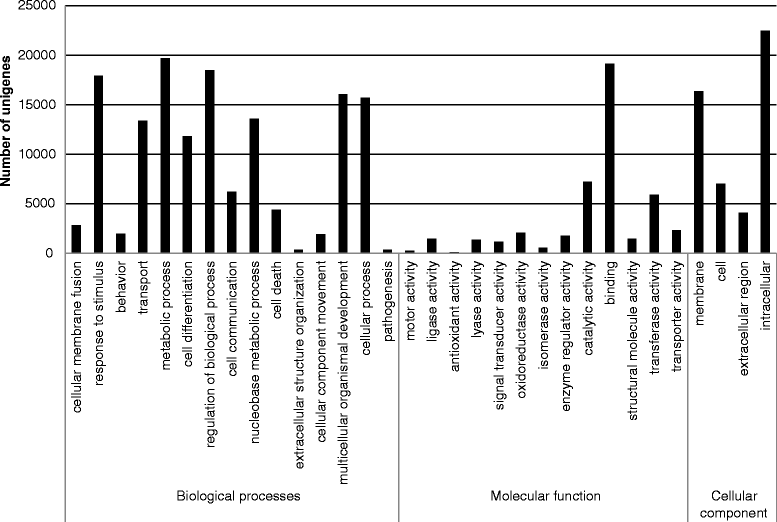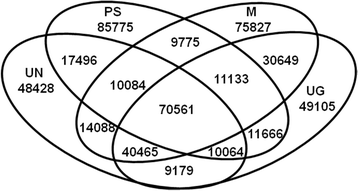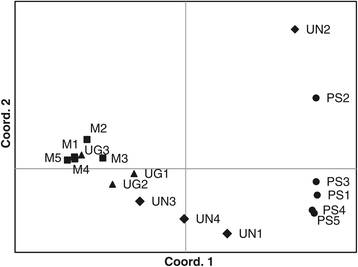Comparative transcriptomics of a complex of four European pine species
- PMID: 25887584
- PMCID: PMC4458023
- DOI: 10.1186/s12864-015-1401-z
Comparative transcriptomics of a complex of four European pine species
Abstract
Background: Pinus sylvestris, P. mugo, P. uliginosa and P. uncinata are closely related but phenotypically and ecologically very distinct European pine species providing an excellent study system for analysis of the genetic basis of adaptive variation and speciation. For comparative genomic analysis of the species, transcriptome sequence was generated for 17 samples collected across the European distribution range using Illumina paired-end sequencing technology.
Results: De novo transcriptome assembly of a reference sample of P. sylvestris contained 40968 unigenes, of which fewer than 0.5% were identified as putative retrotransposon sequences. Based on gene annotation approaches, 19659 contigs were identified and assigned to unique genes covering a broad range of gene ontology categories. About 80% of the reads from each sample were successfully mapped to the reference transcriptome of P. sylvestris. Single nucleotide polymorphisms were identified in 22041-24096 of the unigenes providing a set of ~220-262 k SNPs identified for each species. Very similar levels of nucleotide polymorphism were observed across species (π=0.0044-0.0053) and highest pairwise nucleotide divergence (0.006) was found between P. mugo and P. sylvestris at a common set of unigenes.
Conclusions: The study provides whole transcriptome sequence and a large set of SNPs to advance population and association genetic studies in pines. Our study demonstrates that transcriptome sequencing can be a very useful approach for development of novel genomic resources in species with large and complex genomes.
Figures




Similar articles
-
Development of a single nucleotide polymorphism array for population genomic studies in four European pine species.Mol Ecol Resour. 2020 Nov;20(6):1697-1705. doi: 10.1111/1755-0998.13223. Epub 2020 Jul 28. Mol Ecol Resour. 2020. PMID: 32633888
-
Speciation history of three closely related pines Pinus mugo (T.), P. uliginosa (N.) and P. sylvestris (L.).Mol Ecol. 2011 Apr;20(8):1729-43. doi: 10.1111/j.1365-294X.2011.05037.x. Epub 2011 Mar 7. Mol Ecol. 2011. PMID: 21375633
-
Combined de novo and genome guided assembly and annotation of the Pinus patula juvenile shoot transcriptome.BMC Genomics. 2015 Dec 12;16:1057. doi: 10.1186/s12864-015-2277-7. BMC Genomics. 2015. PMID: 26652261 Free PMC article.
-
Transcriptome sequencing in an ecologically important tree species: assembly, annotation, and marker discovery.BMC Genomics. 2010 Mar 16;11:180. doi: 10.1186/1471-2164-11-180. BMC Genomics. 2010. PMID: 20233449 Free PMC article.
-
Candidate Genes for the High-Altitude Adaptations of Two Mountain Pine Taxa.Int J Mol Sci. 2021 Mar 27;22(7):3477. doi: 10.3390/ijms22073477. Int J Mol Sci. 2021. PMID: 33801727 Free PMC article.
Cited by
-
Chemical characterization and identification of Pinaceae pollen by infrared microspectroscopy.Planta. 2018 Jan;247(1):171-180. doi: 10.1007/s00425-017-2774-9. Epub 2017 Sep 14. Planta. 2018. PMID: 28913637
-
275 years of forestry meets genomics in Pinus sylvestris.Evol Appl. 2019 Jun 28;13(1):11-30. doi: 10.1111/eva.12809. eCollection 2020 Jan. Evol Appl. 2019. PMID: 31988655 Free PMC article. Review.
-
Evolutionary history of the mediterranean Pinus halepensis-brutia species complex using gene-resequencing and transcriptomic approaches.Plant Mol Biol. 2021 Jul;106(4-5):367-380. doi: 10.1007/s11103-021-01155-7. Epub 2021 May 1. Plant Mol Biol. 2021. PMID: 33934278
-
Atlas of tissue-specific and tissue-preferential gene expression in ecologically and economically significant conifer Pinus sylvestris.PeerJ. 2021 Aug 18;9:e11781. doi: 10.7717/peerj.11781. eCollection 2021. PeerJ. 2021. PMID: 34466281 Free PMC article.
-
Full-Length Transcriptome Sequencing-Based Analysis of Pinus sylvestris var. mongolica in Response to Sirex noctilio Venom.Insects. 2022 Mar 30;13(4):338. doi: 10.3390/insects13040338. Insects. 2022. PMID: 35447780 Free PMC article.
References
Publication types
MeSH terms
Substances
Grants and funding
LinkOut - more resources
Full Text Sources
Other Literature Sources
Research Materials
Miscellaneous

